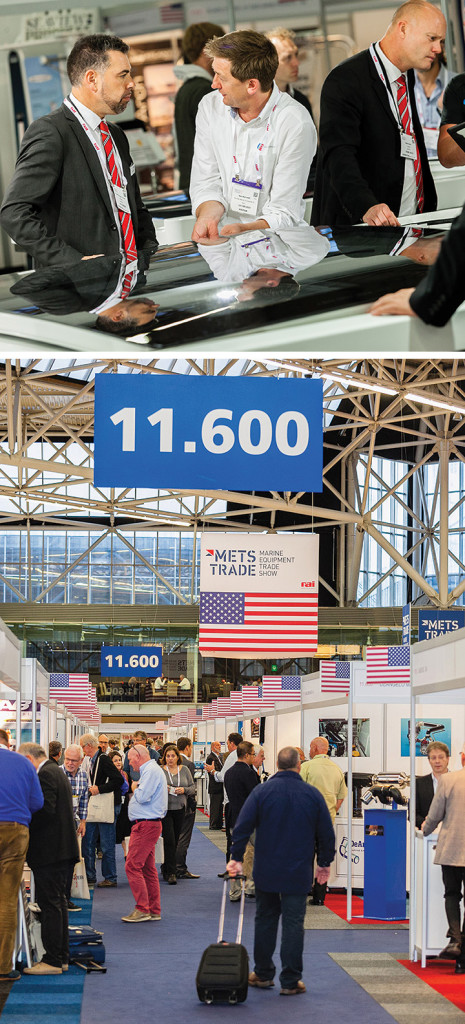Stronger U.S. dollar puts pressure on exports

Economic rebound good for industry, but stronger U.S. dollar making exporting more difficult
Nowhere has the rebirth of the U.S. economy been more evident than in the recreational boating industry. Once quiet factories now hum with activity as manufacturers churn out exciting new products. Dealer lots no longer house significant volumes of non-current inventory, and the noise level at winter boat shows is audibly louder – clear evidence of deals being made and money changing hands.
Not only did the recovery directly power a coincident rebound in the world’s strongest boating market, but the improved prospects of American consumers have lifted the fortunes of boat builders all over the world, spawning a ripple effect that has contributed to a wider, global economic uplift.
The recovery of the U.S. economy over the past two years has gone hand-in-hand with a recovering U.S. dollar. The value of the U.S. dollar is measured by the U.S. Dollar Index (or DXY), which is an index of the value of the greenback relative to the currencies of our major trading partners, including the Euro, the Japanese Yen, the British Pound Sterling, the Canadian Dollar, the Swedish Krona and the Swiss Franc. The DXY goes up when the U.S. dollar gains value compared to these other currencies.
The buck hit rock bottom in April of 2008, when one U.S. dollar was worth just 71.32 cents in international trading – an all-time record low. By January 1, 2016, it had climbed back to 98.35 cents – roughly the same level where it sat prior to the downturn. The consensus among the banks is that the dollar will remain somewhere around par at least through 2017. So looking forward, what does it all mean for the recreational boating industry?
Greater purchasing power for importers
As the largest boat and boating equipment market in the world and the world’s strongest economy, the United States is the engine of growth that drives global markets. The U.S. market is so large, so strong, so driven by consumption, and so partial to product that is different, that it has the capacity to directly impact production in European and Asian nations. When the U.S. boating market does well, it isn’t just domestic suppliers who benefit.

A stronger U.S. dollar brings benefits to dealers, distributors and manufacturers alike. A strong dollar gives dealers increased purchasing power, and it allows distributors to obtain better deals on aftermarket goods from all over the world – everything from electronics to rain suits – which translates into better margins in the chandlery. A stronger dollar can also help U.S. boat manufacturers when they need to source raw materials and finished components. That’s especially true in the case of product that is imported into the United States.
A higher cost of goods for exporters
A strong U.S. dollar is a bit of a double-edged sword. While it affords U.S. buyers with greater purchasing power, it also makes American goods more expensive to buy in a global market.
“It is true that the growing strength of the dollar is making things a bit tougher right now for U.S. exporters,” said National Marine Manufacturers Association President Thom Dammrich. Pushback against price increases is normal, he says – in this case, the price increase resulting from U.S. dollar exchange rates returning to a point near their long-term average, following a few years of lower values in the wake of the 2008 downturn.
“Before the downturn, when rates were similar to where they are today, it was a non-issue,” he said.
Aquatic AV CEO Robert Fils said he can accept losing a short-term competitive advantage based on a favorable exchange rate when the trade-off is a healthier global economy overall.
“The rapid rebound of the U.S. dollar has definitely had an impact on our sales, particularly in Europe. But that’s a short-term situation,” he said. “What’s more significant is that the European economy is starting to finally show some movement. It has been down for such a long time, now we’re seeing evidence of it picking up steam. That should reduce price sensitivity to some degree, and ultimately result in higher overall volumes.”
“We are hearing feedback from some of our overseas distributors, who are feeling a bit of margin compression from the currency exchange rate,” adds Bennett Marine CEO Charles Sweet. “The reality is we look at pricing all the time, and we work with our OEMs and our distributors in any way we can. But in our market segment I would say that pricing issues are driven more by competitive pressures than the exchange rate. For a long time Bennett was alone in the trim tab market, and now we have multiple competitors. It’s good for the consumer, since competition drives innovation, it drives product quality, and it drives everyone to deliver superior service. There’s always going to be margin compression from competition or economic considerations. You have to be prepared to deal with it, whichever way it goes.”
Of course, the manufacturers most insulated from exchange rate pressures are those who have the ability to manufacture locally within their overseas markets, whether through the operation of wholly-owned subsidiaries or through licensing arrangements.
“We manufacture aftermarket products in Europe and sell them through a distributor based in the Netherlands,” said Rick Reyenger, CEO of Maryville, Tenn.-based Marine Accessories Corporation. “Because of that, the recent increase in the U.S. dollar hasn’t really impacted our sales in Europe at all. In fact, they’re up over the previous year. Between Europe, the Middle East and Africa we sell into approximately 18 countries, and it just makes sense for us to manufacture product for that market over there.”
Dammrich feels that the resistance U.S. exporters have been facing will subside because few American firms compete on price to begin with.
“If you’re going to export, you can’t just jump in and out of the market whenever the exchange rate happens to be in your favor. Your customers need to know that you’re there for the long haul, and that you will be there for them through the ups and downs,” he said. “There is a lot of data out there which shows that companies that export are more profitable, they pay higher wages, and they’re generally just more successful. So while the stronger dollar might be making it a little harder for American manufacturers in price-sensitive markets right now, the benefits of exporting are still substantial.”
NAFTA implications
The exchange rate picture grows muddier when we look at goods produced within North America, thanks to the tight economic integration that exists as a result of the North American Free Trade Agreement (NAFTA).
Consider this scenario: a marine parts and accessories manufacturer in the U.S. might take advantage of the attractive exchange rate to source raw aluminum from a mine in Canada. It may then form the raw aluminum into a cleat, seat base or other piece of boat component, then sell it back to a Canadian boat manufacturer like Princecraft, Kingfisher or Campion Marine. The boat subsequently built with that product might, in turn, wind up being sold to a dealer in the U.S., meaning that original piece of aluminum will have crossed the same border three times before it even arrives on the showroom floor. In each of those three instances, its price will be directly impacted by currency exchange rate fluctuations. Prior to NAFTA, it would have been taxed three different times as well.

The same scenario exists for product manufactured in Mexico, which might be built from raw materials sourced from the U.S. or Canada, and ultimately sold back to American or Canadian dealers.
The potential for currency exchange rates to impact margins compounds if those products are subsequently exported to customers in Europe, Asia, the Middle East or South America. Every time a product crosses a jurisdictional line, its profitability will be slightly enhanced or eroded by currency exchange rates.
A global currency
Because the U.S. economy yields such massive economic clout, the U.S. dollar long ago became the de-facto currency for a number of businesses worldwide, regardless of where they’re located. Operating in U.S. currency on both sides of the balance sheet is one way for companies located abroad to help protect their margins from higher costs associated with exchange rate variations. Because the dollars on the sale side are always larger than on the purchase side, the theory is that one will still be able to realize a profit regardless of any currency shift.
While it may be tempting for foreign distributors to monitor daily currency rates and try to buy when the exchange is most favorable, the cost of warehousing and carrying goods in inventory for long periods of time may negate any actual savings. It also increases the risk of loss to obsolescence, when a new product lowers the value of existing inventory.
The year ahead
Economically speaking, 2015 was a good year, both in the U.S. and for the most part, worldwide.
In October, the International Monetary Fund (IMF) released its World Economic Outlook, which forecasts the global economy to expand by 3.6 percent in 2016, up from 2015’s 3.1 percent growth. Growth in Europe is expected to rise from 1.8 percent in 2015 to a healthy 3.4 percent in 2016 as those economies continue to rebound. Increases on a similar scale are forecast for Latin America and the Caribbean.
The Organization for Economic Cooperation and Development (OECD) is also showing a positive global growth forecast of 3.6 percent, even in light of growing concerns over volatility in China’s stock market. OECD is forecasting softer growth in Europe, at 2.0 percent, and notes that the higher value of the U.S. dollar should be offset in trading to some degree by continued low interest rates.
Closer to home, Mexican economic growth is solid, with low inflation and low unemployment. And in spite of oil prices currently sagging in the range of $42 a barrel, Canada is forecast to exhibit stronger growth in 2016 on the strength of a growing manufacturing sector.
Here in the U.S., importers will continue to enjoy the strong purchasing power of the U.S. dollar, while manufacturers who export should see price sensitivity begin to decline as a result of overall economic growth in key markets.





Offering terms of credit to your overseas clients is one of the best ways to mitigate the stronger U.S. dollar. Thankfully, EX-IM Bank is back in business and working to finance the export of U.S. manufactured goods.